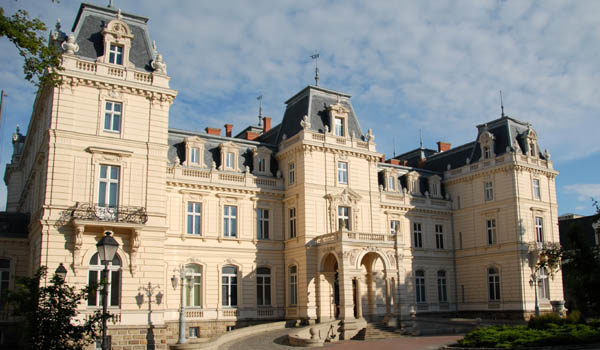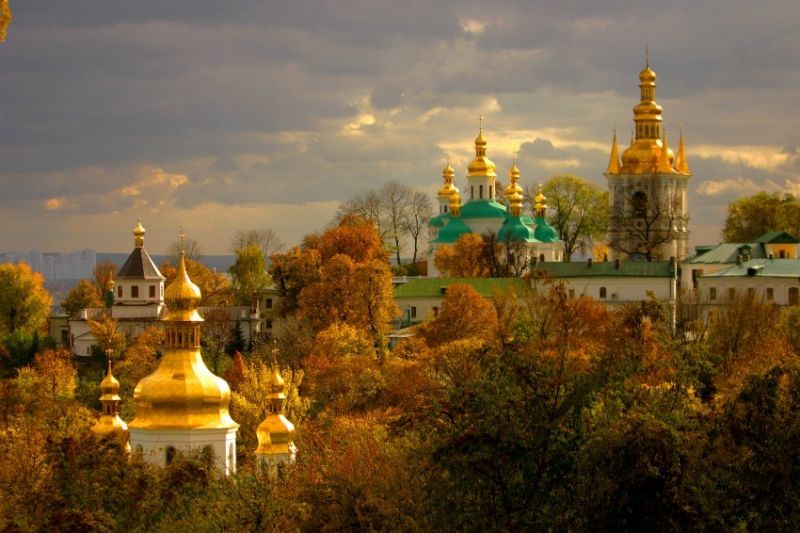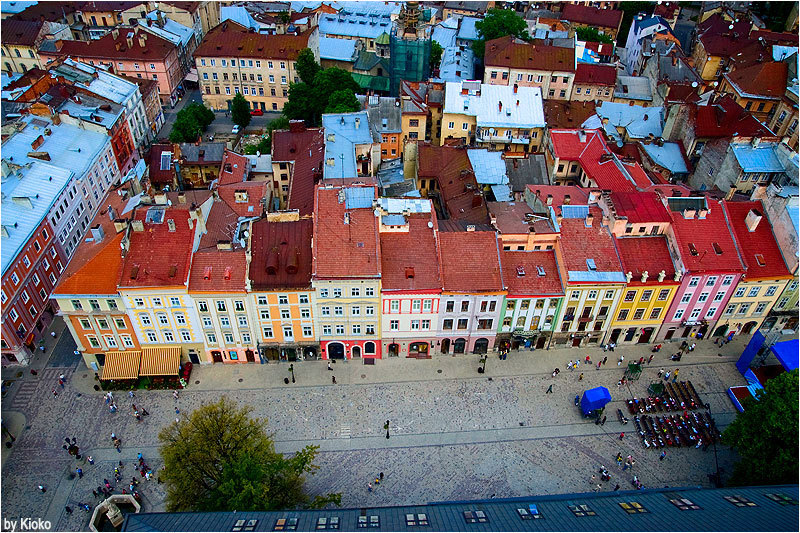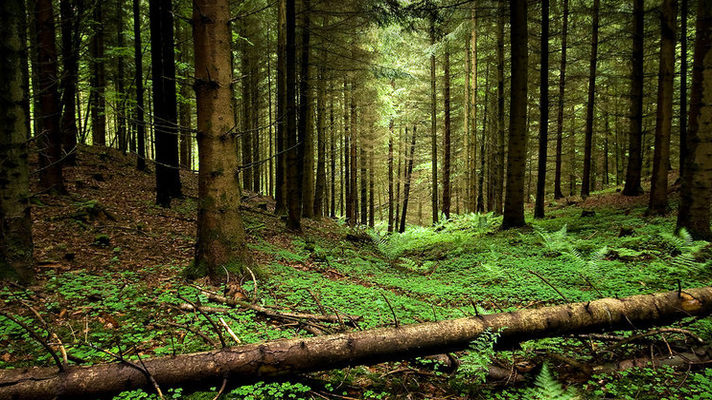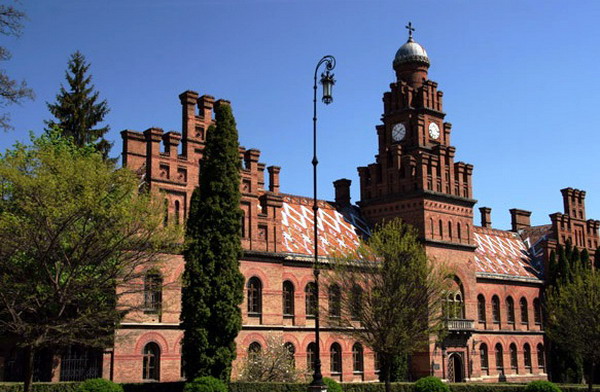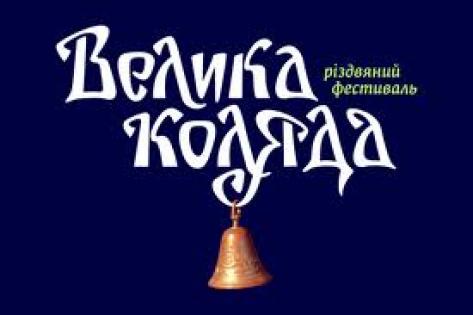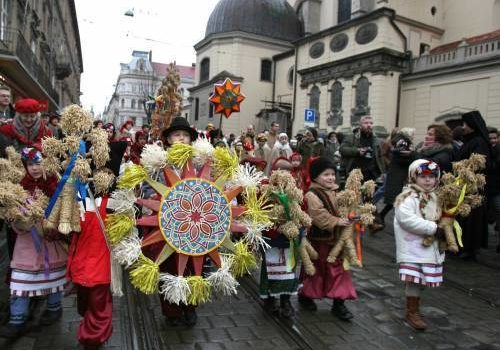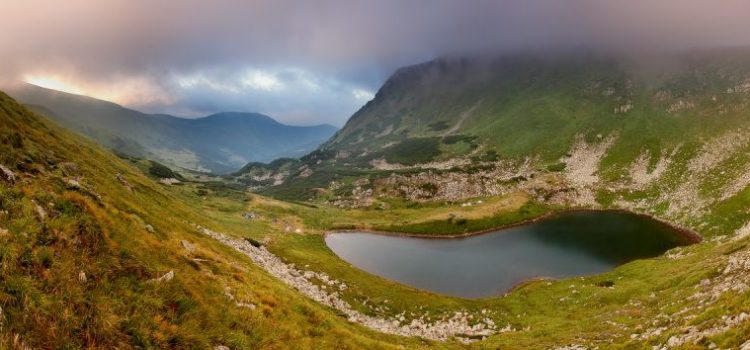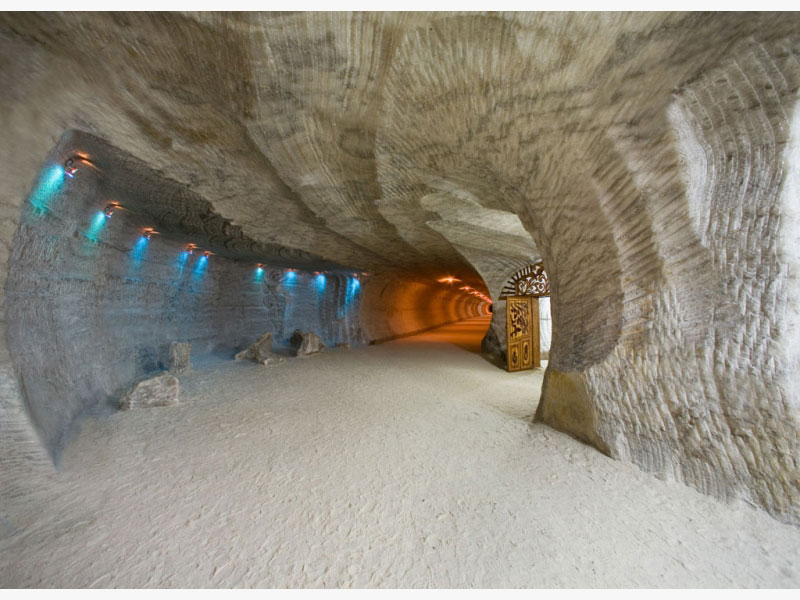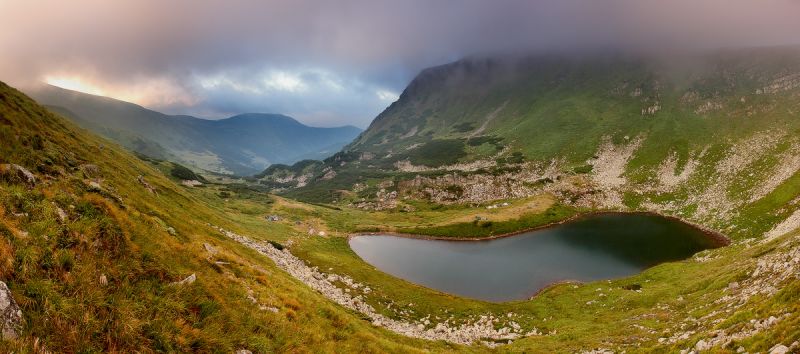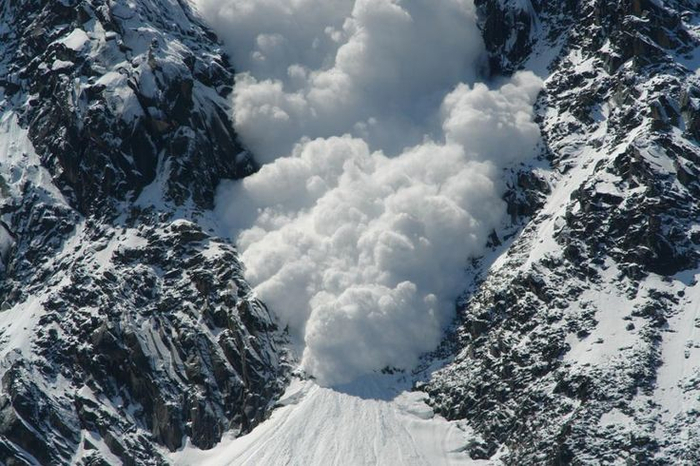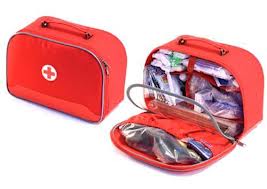VI Міське Свято Шоколаду
Дата проведення: 14-17 лютого 2013 року
Місце проведення: Палац мистецтв (вул. Коперника, 15)
Документальний фільм «Наш Львів»
Прекрасний документальний фільм, у якому розповідається про різні етапи життя міста Львова. Основний історичний літопис, львівські кам’яниці, видатні постаті, місця, музеї, будинки та багато іншого.
Щоб краще “засвоїти” побачене пропонуємо приєднатись до одного з наших турів по Львову. Особливою подією для вас стане унікальний тур- “Театралізована екскурсія нічним Львовом”
Top 10 Places that Must Be Visited in Lviv
If you have stayed in Lviv in transit or, for some other reasons, you do not have enough time to see all beauty of the city Lviv.Travel web site recommends Top 10 architectural pearls of Lviv which must be seen by everyone who comes to visit the city. All of them are situated in a central part of the city, so that it will take you no more than 3 hours to see them all.
1. The Market Square
Lviv Market Square has maintained its name from the XIV century. It originates from German ‘der Ring’ (‘a circle’) because the central squares of German medieval cities were built in this shape.
In the middle of the XIV century, by order of king Kazimierz III, in the valley of the Poltva River, German colonists established a typical European city with a traditional market square. Polish king had been constructing the city with the help of the most recent building technologies of that time. To do it, he invited German artisans and builders. In the next centuries, the architectural perfection of the Market Square had been added by Italian and Austrian architects.
The modern Market Square is a stratification of architectural ideas of many creators and centuries which, however, have one peculiarity – the unchanged coordination and harmony. Here all buildings breathe piece, confidence, optimism, and kindness of the European Renaissance epoch. All stone buildings are different and unmatched but, at the same time, they seem like to be brought together by the same idea. Each edifice is a separate and a completed image. Here, the magnitude of the buildings is contrasted to the height of a person, and we feel ourselves being surrounded by a very cozy interior. The buildings are neither too high, nor too small; none of them protrudes from the general assembly by its size, height or style. One can hear real music coming from Lviv Renaissance buildings. Unsymmetrical windows – two of them situated side by side and the other one aside – have utilitarian purpose. Two windows pertain to the main hall – the front room, while the third one pertains to the side room – the housekeeping area. However, one can feel a rhythm in this asymmetry; it seems like firstly, one can hear the sound of two half-notes followed by a whole one. The sound of the Market Square is unmatched.
Lviv ancient patricians ordered plans of their houses mostly from Italian architects from northern Lombardy and southern Switzerland. However, the Italian Renaissance in Lviv could not maintain its purity and style inviolability. It had been added and enriched by local traditions, in particular, the features of eastern Ukrainian architecture. In this way, during almost five centuries, the only unmatched assembly of dwelling buildings in Ukraine had been created on the Market Square. Almost all edifices of the square have been used for their designated purposes: Lviv residents dwell there.
2. The Opera House
Being built at the beginning of the last century by the project of Zygmunt Gorgolevsky, the architect, the Big Theatre in Lviv had been compared to Paris and Vienna opera houses. Standing in front of the huge façade of this fantastic edifice, one can feel the omnivorous power of art and its eternity in contrast to a fleeting human life. This building presents different architectural styles of European countries embodied in eloquent impressiveness.
The forms of the façade are various and complicated; they include columns, balustrades, and bays decorated with allegorical sculptural figures. The statues of eight muses tower above the main front cornice of the façade; a high relief ten-figured composition “Joy and Suffering of Life” is set over them. The gable at the top is decorated by a sculptural triad of bronze winged figures of the Genius of drama, comedy, and tragedy. In the center, there is Glory who holds a golden palm branch. These sculptures were created by the famous Lviv artists Popel, Baron, and Viytovych.
The interior of Lviv Opera House is no less impressive than its outer look. The building inside is decorated with gilding (a few kilos of gold were spent on it), different color marbles, decorative paintings, and sculptures. The four-layer auditorium is constructed in a form of a lyre and accommodates more than a thousand of people. The picturesque curtain – the “Parnas” (1900), painted by a famous European artist Henryk Semyradskyi, is the main adornment of the scene. It is an allegorical interpretation of human life presented by the personages of the Parnas.
The auditorium of the Lviv Opera House is marked by its perfect acoustics. Here, one can watch the performances of famous opera and ballet bands of Ukraine as well as guest artists from other countries. Recently renewed Vienna balls have been held in Lviv Opera House.
3. The Armenian Quarter
Armenian community, which is one of the oldest communities in Lviv, since ages has been creating the center of their national life with the unique architecture and the original spirit of the ancient Eastern Christian culture.
The Armenians, being expelled from their motherland by the Mongol and Tatar invasion in the middle of the XIII century and deprived of their nationhood, found hospitable shelter in Halychyna. Together with their assets, one of the oldest Eastern Christian nations (the Armenians adopted Christianity a few centuries earlier than other peoples of Europe) brought to the city their creativity and irreproachable skills of jewelers, tanners, and embroiders. However, since centuries, the Armenians have mastered the profession of merchant. Trade caravans exporting goods from Eastern countries to Europe were almost entirely monopolized by the Armenians. The Armenians were engaged not only in trading but also in interpreting, helping foreign traders in Lviv to communicate with each other.
Each national community of ancient Lviv occupied its own territory. The Armenians settled in the northern part of the city, near the central Market Square. That place was a center of Gregorian episcopacy which was subordinated only to the head of the Armenian Church – the Catholicos of all Armenians. The prefect (‘viyt’) and the council of elders were the heads of the secular life. In order to solve the internal problems of the community, the Armenians used their own customary laws. For example, if the arsonist was caught red handed, he could have been thrown into the fire right away. The Armenians had their own school, hospitals, library, and a theater. In 1616, they founded the first Armenian printing house. The area reclamation in the Armenian quarter was peculiar, given the trends of that time. Many houses of the second half of the XVIII century had wide entrance gates; some of them have preserved until today.
Strong economic positions that had been lasting for a long time let the Armenian colonies feel confident and withstand the pressure and restrictions of the city authorities. However, the city council, which consisted mostly of rich Rome Catholic tradesmen, unwilling to tolerate Armenian competition, envied their wealth and connections in the East.
Being tradesmen and businessmen, the Armenians, who were separated from their homeland, could not maintain their identity for a long time. The assimilation was the only possible way to preserve the wealth and social status of Lviv Armenians. In 1630, the Armenian Archbishop Mikolaj Torosowicz adopted Catholicism; however, this event did not do any good for the Armenians. To compare, in the middle of the XVII century, there lived more than two thousand Armenians in Lviv, while in the early XX century, there were almost none of them left in the city; there remained only Poles with Polonized Armenian surnames. A new wave of Armenian settlement in Lviv began after 1939 with the arrival of Russian totalitarianism. Nowadays, this community consists of Armenians of different parts of the former Soviet Union.
4. The Potocki Palace
Behind the fence with the ornamental metal gate, one can see the majestic yet refined edifice. The impressive palace is decorated with reliefs, moldings, wall paintings, and stained glass. The Potocki Palace is a vivid example of mature historicism and one of the most interesting architectural landmarks of Lviv. It was designed by a French architect Louis d’Overnu at the order of Count Alfred II Josef Potocki (1817-1889), the governor of Halychyna and Lodomeria. The construction had lasted from 1888 till 1890 under the supervision of Lviv architect Julian Tsybulski who also introduced some minor changes to the project plan.
The interior of the first floor of the palace is mostly executed in the style of King Louis XVI. The halls (the Red Hall, the Mirror Hall, the Blue Hall, and the Ordinat’s Office) are adorned with artificial marble, gilding, moldings, and mirrors. Marble fireplaces are decorated with gilded bronze.
On the first floor, there is a chapel with a miracle-working icon of Virgin Mary of Lviv (the XV century). On the second floor, there is an exposition of Lviv Art Gallery. It meets the visitor with the Antique Arts Hall. European art of the XIV-XVIII centuries is presented by the best works of the collection: the Ukrainian icon of the XV century “Saint Paraskeva”, the paintings by M. Basaiti, J. Zucchi, S. Ricci, J.-E. Liotard, J. Guerin, and F. Goya, among others. Many different conferences, presentations, chamber concerts, and political meetings often take place in the palace.
5. The Boim Chapel
This unique landmark is the adornment of the Cathedral Square; the alley opens up one of the best views of the Market Square and the City Hall. Once, Lviv merchant of Hungarian origin, Georgy Boim, who came into a fortune due to wine trade, after receiving Lviv citizenship along with the position of mayor, decided to build a family chapel of an unmatched beauty. The building was erected upon the project of Wroclaw builder Andreas Bemer and was consecrated in 1615.
Another façade on the side of Halytska Street is decorated by the old original mural portraits of Boim and his wife. The third façade has a splendid relief depicting Saint George.
The dome of the chapel is crowned by a statue of mourning Christ in Gethsemane asking the Father to deprive Him of His suffering on the cross. The subject that is often represented in oil painting is truly unique in the sculpture. The exterior wall of the chapel is decorated by solid stone carvings depicting the Holy Passion and the figures of Saint Peter and Paul. The interior of the chapel is no less magnificently ornamented. According to custom of that time, for creating multi-figured compositions, ordinary people were used as models. Thus, it is possible to see here the faces of real people of the ancient epoch.
The Boim Chapel is famous for its good energetics: the museum worker told a story that once she had forgotten a sack of apples in the corner of the chapel. After more than a year and a half she suddenly came across the sack and discovered that the apples had preserved their freshness and scent.
The Boim Chapel is open to visitors only during summer months.
6. The Dominican Church
The Dominican Monastery was founded in the XIII century at the will of the Ukrainian Prince Lev Danylovych’s wife, the Hungarian Princess Constance. She was a Catholic and was missing her faith, being far away from home. From the XV till the middle of the XVIII century, there was a Roman Catholic Church built in the Gothic style in this place.
In 1559, a real war for a bride burst out in this church and on its front square. Lukasz Gorka, the magnate, aimed at the monastery to give out his, as he thought, lawful wife, Halszka Ostrogska, who hid within the walls of the Dominican Monastery. She was the richest heiress of the Polish–Lithuanian Commonwealth. During the military actions, all trading activity in Lviv was terminated, and the irritated king ordered to stop the war. Finally, the water pipe leading to the monastery was cut, and thus the siege ended. Halszka was given out to Lukasz.
The Gothic Dominican Church was dismantled in 1748 because of its critical condition. The new church, which now resembles St. Charles’ Church in Vienna, was erected in the late Baroque style in 1748-1764 upon the project of a military engineer, General Jan de Witte. In those days, there was a good tradition to save everything valuable that could be maintained from the previous edifice. Nowadays, in the southern part of the church one can see the alabaster gravestone of the XVI century, a reminder of the ancient Gothic church, which disappeared about 260 years ago.
There is a range of gravestones in the church, the most valuable of which is the one of Countess Dunin-Borkowski. These are the works of world famous Danish sculptor Bertel Thorvaldsen (1816). The monument of the governor of Galicia Franz von Hauer created by Schimser (1824) represents Lviv School of sculpture. In 1880, a monument to the famous Polish artist Artur Grottger by Gadomsky was erected here.
In times of Soviet Union, the Dominican Church was closed. Like many other churches of Lviv, this one was used as a warehouse. In 1970, the Museum of Religion and Atheism was opened there. In the middle of the church, the big Foucault pendulum was suspended under the dome. It shoved the process of the Earth’s rotation by its deviations. The museum contained visual aid room where lectures on atheistic topics were conducted and atheistic science-fiction movies were demonstrated.
Since ninetieth, the Dominican Cathedral has become the Greek-Catholic Church of the Holy Eucharist, which now is especially popular among Lviv intelligent and nationally conscious youth.
7. The Bernardine Monastery
Having passed the Hlyniany Tower – the fortification gate of the monastery on the side of Mytna Square, you will get to the monastery courtyard, where each of its many corners breathes with antiquity. Everything has remained the same here; it seems like four hundred years of world history have not changed this place at all.
The Bernardine monastery (which is a Polish version of the Franciscan Order) was built outside the city walls, so that one can see here firm and high fortifications which are well- preserved on the northern and eastern side. The history of the monastery dates back to the XV century, however, in fact, this landmark was built at the beginning of the XVII century. That was the era of extremely rapid changes of architectural styles. In 1600, the most famous builder in Lviv Paolo Dominici Romanus, the Italian, started the construction of the Roman church in the customary Renaissance style; however, he died in 1618 without having finished the edifice.
The Polish King Sigismund, who came to look at the construction, considered the original idea too modest. Thus, Ambrosius Przychylny, the Swiss, the apprentice and the successor of Paolo Dominici Romanus, used the most impressive techniques of that time when continuing the work of his predecessor. The splendid Mannerist sculptural decoration, which, however, does not affect the artistic sense of proportion, is the most valuable heritage of this landmark. More than twenty perfect sculptures make a live gallery of intricate figures of the XVII century. Andreas Bemer, Wroclaw architect, completed the ensemble of the monastery with a Baroque tower and a façade adornment. The church interior is decorated with numerous carved altars of the XVIII century; the walls are covered with original mural frescoes of the same period.
The history that was made within these dark and majestic walls is extremely exciting. Real facts of the city chronicles and legends have intertwined so tightly that they are inseparable now. Among them there is a healing spring that appeared in the monastery courtyard in 1484 after the burial of St. John of Dukla, the defender of Lviv from the numerous sieges, canonized by Pope John Paul II in 1997… The Baroque rotunda over the well where the dead bodies of Ukrainians were thrown into, who, in 1648, wanted to open the gates of the city to hetman Bohdan Khmelnytsky… Finally, the clock on the church tower, which is always five minutes ahead in memory of a Bernardine monk who moved the clock arrow forward, so that the city gate was closed earlier, before the invaders’ attack, thus Lviv was saved from destruction… The dungeons of the Bernardine Monastery also hide many legends and real historical events.
8. The Black House
The Black House got its name in the XIX century because of quite prosaic reason: for centuries, white lead, which was applied as a ground for polychromy (multicolorfulness) had oxidized on exposure to air and light, thus forming its mysterious black color, which was later maintained by routine repairs. Although, in 1960’s, people used to believe that the house got its color because of the juice of green walnut peel being rubbed in the façade for many years.
The mysteriousness of this house feeds on another theory that the façade got its black color because of the soot as a result of many years of building heating. The theory, though, is not recognized by the leading architects of Lviv.
In the Middle Ages, the problem of heating the buildings in winter time was quite serious. In order to keep warmth inside the house, people used to hang the carpets at a certain distance from the walls to create a layer of air. For heating the house, double-chamber stoves were ignited in the basements. Burning wood heated the stones and hot air ascending from them traveled through pipes to all floors. For centuries, the porous sandstone, the Black House is made of, had been actively absorbing dust and soot, thus turning from white to black.
The first owner of this house (to be more exact, the one that stood there before the present one) was Andrew of Kyiv; for this reason it was called Kyivskyi. At the end of the ХVI century, the representative of Lviv patrician family Jan Lorencowicz opened there one of the first pharmacies in Lviv. At that time, the house was called Lorencowychivskyi. In the XVII century, Jan Lorencowicz’s granddaughter married a doctor Marcin Anczewski, thus the stone house was called “Doktorivskyi”. Dr. Anczewski adorned the façade with the sculpture of his patron, St. Martin, cutting his cloak skirt with the sword giving it to the beggar. Here one can also see the figure of Lviv saint Stanislaus Kostka, the patron and protector of the city from fires. At the entrance to the building, there stands the medieval stone bench on which the guard used to sit.
Nowadays, the History Department of the Ukrainian diaspora of the Lviv Historical Museum is situated here. It presents some particular fragments of the three main directions of the Ukrainian migration movement, the chronological framework of which covers late XIX – late XX centuries. The records collected in expositions help to understand more clearly that the Ukrainians, living outside their motherland, are a significant branch of the Ukrainian people and contribute to the treasury of our common history, science, culture, and art.
9. The Lviv High Castle Park
The highest mountain of Lviv (413 meters above sea level and 130 meters above the city level) was created artificially at the end of the XIX century in honor of the Union of Lublin anniversary. Thus, Lviv received an unmatched observation deck comparing to other European cities. Its views cannot leave indifferent anyone who dares to ascend here.
A stone lion, which once stood at the City Hall, and which is over four hundred years old, now guards the foot of the artificial mound. Nearby, there is a fragment of the castle wall, which used to stand on this mountain in the XIV century.
There is a majestic avenue of old chestnut trees on the lower terrace of the High Castle Park. On the avenue, there is a stone raised to commemorate the victory of the Polish King Jan III Sobieski over the Turkish army in 1675 on Lesynytsky fields that are visible from this place.
At the end of the alley, there is a gardener’s house (1892), which is surrounded by many exotic plants. In order to decorate the park, an artificial cave with the inscription “15 August 1841” was placed here in the middle of the XIX century. Its entrance is guarded by two stone lions of the XVII century taken from the old city hall. They hold shields with the emblems of Lviv patrician families. Once, the cave was called “The Suicide Cave”, because people in love who, for some reasons, could not be together with their beloved ones used to commit suicides here.
The High Castle Park is unique because it is located on a high wooded hill in the heart of the big city. It takes about 10-15 minutes to get from the noisy streets to the coolness and comfort of old trees where nothing reminds one of the vanity of urban life.
10. Lychakiv Cemetery Museum
The cemetery was officially founded in 1786 on the initiative of a new Austrian government in the capital of the Kingdom of Halychyna and Lodomeria of that time.
The oldest gravestone in its territory dates 1675. 23 chapel tombs that were owned by wealthy Lviv families are the adornment of the Lychakiv necropolis.
Recently introduced night tours to Lychakiv are a kind of know-how in Ukraine and Europe.
A List of UNESCO’s World Heritage Sites in Ukraine
A list of UNESCO’s World Heritage Sites in Ukraine includes six landmarks (as of 2011), five of which are cultural and one is a natural one. Among them, Saint Sophia Cathedral in Kyiv and Kyiv Pechersk Lavra are recognized as masterpieces of human creative genius. The objects on the list are arranged in order of their addition to the List of World Heritage Sites.
1.Saint Sophia Cathedral in Kyiv
Saint Sophia Cathedral (also, the Wisdom of God, Sophia of Kyiv or Sophia Cathedral)is a Christian cathedral in the center of Kyiv, the landmark of Ukrainian architecture and monumental painting of the XI-XVIII centuries.The cathedral is one of the fewedifices that have preserved since the times of Kyivan Rus. It is one of the most important Christian sacred places in Eastern Europe and the historical center of Kyiv metropolitan.
2. Kyiv Pechersk Lavra
Kyiv Pechersk Lavra,also known as the Kyiv Monastery of the Caves, is one of the largest Orthodox holy shrines of Ukraine, the historical and architectural landmark, as well as a functioning monastery of the Ukrainian Orthodox Church of Moscow Patriarchate with the status of lavra. Since its foundation as the cave monastery in 1051, Kyiv-Pechersk Lavra has been a permanent center of Orthodoxy in Kyivan Rus. Together with Saint Sophia Cathedral it is inscribed on UNESCO’s World Heritage List. In the territory of the Upper Lavra,there is a National Kyiv-Pechersk Historical and Cultural Preserve, which was granted the status of a national one in 1996. Monastic life is concentrated on the territory of the Lower Lavra. Both parts of Lavra are open to visitors. Kyiv-Pechersk Lavrawas added to the list of the Seven Wonders of Ukraine in 2007, based on the voting of experts and Internet users.
3. The Ensemble of the Historical City Centre
The historical center of Lviv isthe place from which the city originates. For a long time, it had been limited only to this area where it developed its political, economic, and cultural life. The ancient part of the Old Cityis inscribed on UNESCO’s World Heritage List.
4. The points of Struve Geodetic Arc
Struve Geodetic Arc (also known as the Russian–ScandinavianMeridianArc) is a network of 265 triangular measuring points that formed 258 triangulation triangles and 60 additional points. It served to determine Earth orientation parameters as well as its shape and size.
5. Primeval Beech Forests of the Carpathians
Primeval Beech Forests of the Carpathiansare atransnational composite nature-made object consisting of ten separate massifs located along the 185 km long axis. It extends from the Rakhiv Mountains and Montenegrin ridge in Ukraine to the westof Polonynyridge, Bukovec Mountains and Vihorlat Mountains in Slovakia
6. The Residence of Bukovynian Metropolitans
The edifice was built on the place of the old bishop’s palace in 1864-1882. Nowadays, the main building of Chernivtsi University is set here. The metropolitan residence appeared due to the efforts of Bishop Eugene Hakman.
Колядуємо у Львові! V Етнофестиваль «Рок–Коляда»
Святкування Різдва у Львові вже вчетверте буде доповнене унікальним для України етнофестивалем – «Рок–коляда». Особливість фестивалю – виконання народних колядок та щедрівок не у традиційному народному звучанні, а в етно–роковому стилі.
Що подивитися іноземцеві в Україні: поради світового путівника
Іноземним туристам в Україні радять побувати в Києво-Печерській Лаврі, побувати в Одесі та Львові, й обов’язково проїхатися в “плацкарті”.
У 2011-му році туристичний портал Lonely Planet зарахував Україну до десятки країн, які можна відвідати без великих витрат. Бідна країна, багата на яскраві традиції та щиросердних людей – так описує Україну lonelyplanet.com.
Києво-Печерська Лавра стоїть у списку “must see” під номером один. Туристам радять “відкрити для себе таємниці православ’я”, спустившись у печери та побачивши мощі святих. Також іноземців закликають відвідати тамтешні музеї, зокрема музей мініатюр.
За ландшафтом нашу країну порівнюють із млинцем, і це робить Карпати справжньою туристичною “родзинкою”. Шанувальникам пішого та велотуризму радять прогулянки лісистими пагорбами та квітучими полонинами й, звісно, підйом на найвищу гору, Говерлу.
Живим серцем України сайт називає місто Львів. Його ж серцем, у свою чергу – площу Ринок із ратушею, пахощами свіжозмеленої кави, столиками на вулиці коло кав’ярень, бруківкою габсбурзьких часів та старо-радянським дзеленчанням трамваїв.
Андріївський узвіз, що в Києві, порівнюють із Монмартром. У цьому місці іноземець має змогу відчути справжній “богемний шарм”, поспостерігати за людьми, придбати усілякий сувенірний непотріб та побачити дім Михайла Булгакова. Його ж “Білу гвардію” називають “чи не найкращим романом про Київ та його мешканців”.
Кам’янець-Подільський, на думку авторів, туристам варто відвідувати не в пік сезону, щоб усе – краєвиди, церкви та фортеці – “могло належати лише тобі”.
Місцем, де можна одразу побачити всю Україну, та де з Закарпаття можна пішки дійти до Полтавщини, називають київський Музей національної архітектури та побуту Пирогово. Звезені з усієї країни хатки, млини та церкви заразом слугують чудовим фоном для фольклорних фестивалів, які тут нерідко влаштовуються.
Денна Одеса з її пляжами, музеями, парками, славнозвісними Потьомкінськими сходами не дасть гостям нудьгувати. Одначе справжнє життя міста, з танцями на березі Чорного моря та музичним розмаїттям, розпочинається лише ввечері, зазначає сайт.
“Місто-сад” Бахчисарай туристам радять відвідати заради знайомства з культурою, кухнею та традиційними ремеслами кримських татар. У тамтешніх сімейних готелях можна знайти найкращий та найдешевший сервіс, упевнені автори.
У місті Коломия гостям слід обов’язково зазирнути в музей “Писанка”, збудований у формі яйця, та помилуватися архітектурними пам’ятками, що лишилися від часів Австро-Угорського панування.
Коли враження від України зводяться до непривітних адміністраторів та фарбованих продавчинь – хіпі-атмосфера липневого фестивалю в Шешорах стане для вас приємним сюрпризом. Якби звести докупи американські фестивалі Woodstock та Burning Man – ось що таке Шешори, запевняє сайт.
Іноземцям варто буде побачити й дендропарк “Софіївка”, що в Умані. Більше 150-ти гектарів із гротами та водоймами подарував своїй дружині Софії польський магнат ХVIII-го сторіччя замість банальних цукерок, букетів чи каблучок. Вона ж за це відплатила зрадою з його ж сином.
Судакська фортеця колись використовувалася генуезькими торгівцями. Піднявшись на руїни сьогодні, можна уявити себе в оточенні лицарів та чекати появи білих вітрил на горизонті.
Дунайський біосферний заповідник є найбільшим у Європі водно-болотистим комплексом. Мало хто з туристів дістається до цього місця, а той, хто таки приїде – зможе побачити дивовижно красиві пейзажі та розмаїття птаства, а затишний вечір провести в Вилковому – містечку, яке називають “українською Венецією”, завдяки його системі каналів.
Туристам неодмінно слід відвідати стародавні печерні міста Криму – Мангуп-Кале та “Сіон караїмів” Чуфут-Кале.
“Квінтесенцією вражень” про колишній СРСР сайт називає поїздку потягом, особливо в плацкартному вагоні. Усі сусіди швидко знайомляться, діляться їжею й напоями, розповідають історії. Як іноземець, ви одразу опинитеся в центрі уваги, тож приготуйтеся відповідати на купу запитань, попереджають автори.
Тому, хто хоче просто неба придбати 5-літрову банку корнішонів, або ж коробку передач для автівки Lada, або ж кілограм сала, або ж парфум-підробку, радять неодмінно зазирнути на один із неперевершених українських базарів. Вони є в кожному місті, проте найбільші знаходяться в Одесі, Харкові, Києві та Чернівцях.
Джерело
life.pravda.com.ua
Святкуємо Різдво у Львові на фестивалі “Спалах Різдвяної звізди”
Традиційне вертепне дійство на Різдво у Львові розпочинається у Музеї народної архітектури та побуту. Тут зможете потрапити в атмосферу давнього села, де хатки сповнені сімейним затишком, де у колі рідних по духу людей звучить дзвінка коляда у сяйві різдвяних звізд.
Протягом двох святкових днів можна побачити виступи вертепів, колядування творчих колективів міста, «Святкову ходу звіздарів» центральними вулицями Львова, представлення Різдвяних звізд, взяти участь у зимових іграх та конкурсах, українських забавах та традиційних народних танцях, а також прокататися на санях під час екскурсійної подорожі Музеєм.
Interesting Facts about the Carpathian Mountains
The highest situated village in Ukraine is Vypchyna, Chernivtsi Oblast, located at an altitude of 1100 meters above sea level.
The highest mountains in Ukraine can be found in Rakhiv. The average altitude of the city is 820 meters above sea level. Rakhiv holds another record; it has the biggest vertical drop between the streets that makes 600 meters: 400 meters from the lowest one, 1000 meters to the highest one.
The highest situatedworking place is a research facility –a biostationarof Lviv department of the Institute of Botany of National Academy of Science of Ukraine, located inPozhyzhevskavalley (1429 meters above sea level). It includes a weather station and an avalanche research station. The institution was built in 1899.
The deepest situated hospital is in Solotvyno village, Transcarpathian Oblast. Over 200 years, salt of superior quality has been minedthere. In 1968, the members of Uzhhorod department of Odessa Scientific-Research Institute of Balneologydecided to use the microclimate of Solotvyno mines for treating bronchial asthma. The allegro logical hospital that accommodates 250 people was opened there. The underground wardsfilled with highly dispersed salt aerosol are located at a depth of 206 and 282 meters in a thick salt layer. The duration of one treatment session is about two hours for 30 days. Patients descend to the salt wards via the elevator. The conditions, which are impossible to create on the ground, are the following: constant temperature (23 degrees), humidity (up to 40%), salt-saturated atmosphere(10 mg per 1 cubic cm), absolute silence, completely non-allergic environment, and the number of microorganisms in the air is 5 times lesser than in the most sterile operating room.
The highest situated resort is in the village Vorokhta, Ivano-Frankivsk Oblast. Its altitude makes 850 meters above sea level. There are two tuberculosis sanatoria “Hirske Povitrya” (“Mountain Air”) and “Vorokhta”.
The first geological map of Ukraine was the map of the Carpathiansdrawn by S. Stashyts in 1809.
The most significant paleontological finding in the territory of the Carpathian Mountains is the remains of fossil fauna in the village Starunya (now in Bohorodchany district, Ivano-Frankivsk Oblast). In 1907, there were accidentally found the remains of animals of the late glacial period. Near the stream Lukavets Velykyi, in ozocerite mine, at the depth of 12.5 meters, there were found the remains of a mammoth, a hairy rhinoceros, a giant deer, and different species of fossil birds and amphibians. Apparently, salt, ozocerite, oil solution, and oxygen-free conditions of the ground helped to preserve the ancient animals. With the help of radiobiology, it was determined that the rhinoceros had been buried there for about 23 255 ± 775 years. Speaking about the way the animals appeared there, it is most likely that theUpper Paleolithic people inhabiting the current Starunyaarea were hunting them. Theytricked the animals into the swamp where they died. The results of a thorough study of the findings made in 1907 and 1929 by E. Nezabytovskyi-Liubych, M. Lomnytskyi, and other researchers were published in several monographs and special periodical, titled “Starunya.”
The highest situated construction is a 5 meter high monument on Hoverl a mountain erected in 1996. It features the state symbols:
ablue and yellow flag and a trident.
The highest situated constructioncan be found on the top of Pip Ivan mountain. It is a stone building that once used to be a meteorological-astronomical observatory. Its grand opening took place in the summer of 1938. The astrograph with a 33 cm lens diameter was the main astronomical tool used in the observatory.
During World War II, this building, also known as the “White Elephant”, fell into disrepair and is waiting to be repaired one day.
The highest situated hotel is “Berkut”, which can be found on Yablunytsya mountain pass. It is located at an altitude of 931 meters above sea level. The hotel was built in 1968.
The longest railway tunnel is situated between Skotarskeand Beskyd. Its length is 1747 meters. The tunnel was built in 1887.
The longest viaduct is a railway bridge between Volovets and Beskyd. It was built in the mid 1880’s.It is 33 meters high and 270 meters long.
The world’s largest stone railway bridge can be found in Vorokhta village. It was built in 1895. It is 130 meters long and 65 meters wide.
The highest situated sports facility is located nearby village Yasynya at an altitude of 1450 meters. It is a sports-training center Drahobrat. This village is a unique Carpathian valley rich in snow. The training season here begins in December and ends in April. Interestingly, in 1993, ski training season lasted until July 15!
The largest among high situated sports facilities is a comfortable training center Tysovets which is located near Skole town, Lviv Oblast, at an altitude of 1000 meters above sea level. It is designed to accommodate 450 people.
The highest situated railway station is “Beskyd” built at an altitude of 790 meters above sea level.
The longest wind instrument is trembita, which is a conical wooden tube without side openings thatreaches 4 meters in length. It is mostly popularin Hutsul, Bukovyna, and Boikivshchyna regions and is still used in the villages for signaling or information exchange. The range of trembita is 2.5 octaves; its sound can be heard for more than 10 kilometers.
The Forest Museum can be found in the Transcarpathian village Ust – Chorna. The collected exhibitsgive information about the difficult, dangerous, and yet the most popular occupation in this land of mountains and forests. Here, one can find an interesting collection of vehicles of all times designed for forest works. There are drays, tractors TDT-40, and trestles for wood loading. Among the exhibits, there are nursery gardens of young fir trees, maple, and beech. Besides, one can find trees of unusual shapes formedby lightning strike or strong winds.
The biggest plateau is situated in Chyvchyny mountains at an altitude of 1750 meters above sea level. It is a flat top of the mountain Palenytsya.
The highest situated lake is Brebeneskul, located on the slope of the mountain Hutyn-Tomnatyk at an altitude of 1801 meters above sea level. It is 134 meters long and 44 meters wide; its area covers 4000 square meters, and its maximum depth is 2.8 meters.
The largest mountain lake is Synevyr in Mezhyhirya district of Transcarpathian Oblast (Tereblya basin). Its area covers 7 hectares, and it is 24 meters deep. People also call it the “Blue Eye” or “Carpathian Ritsya.” A strong earthquake or, perhaps,many centuries of weathering caused a landslide of rocks that dammed up themountain stream and formed a lake at an altitude of 989 meters above sea level.
The highest situated mountain swamp is located in the anticline between Breskul and Pozhyzhevska valleys at an altitude of 1800 meters above sea level. This subalpine hollow mud incirque glacier was formedas a result of lake swamp. These swamps also include the ones in Ozerne grotto (1750 meters) and at the foot of Brebeneskul mountain (1700 meters).
Hanging swamps are considered to be the most unusual swampsthat are situated on the slopes of the mountains. The biggest among them is Hlystove swamp located on the southern slope of Hrynyavy mountains at an altitude of 1450 meters above sea level. It is very rich in flora: there are, for example, 17 species of aspen. This swamp has been a natural landmarkof national importance since 1975.
A cave with transparent walls. Nearby Mala Uholka village in Tyachivregion, Transcarpathia, close to Pohar mountain, there is a karst cave. It was formed in Jurassic marble limestones and created by two perpendicular cameras 5 and 20 meters long. The walls are covered with a milky-white transparent calcite with greenish drop stones that look like beautiful flowers. The cave has a great scientific and aesthetic value.
Pearl Cave.2.5 kilometers from Mala Uholka village, at the watershed of the two rivers Mala and Velyka Uholka, there is a karst cave formed in Jurassic marble limestones. It is an example of interstitial waters influence on slightly soluble carbonaceous rocks. Apart from stalactites, numerous calcite balls, resembling pearls,have appeared on the walls, hence the name.
The Enchanted Valley. In Irshava region of Transcarpathia, in the upper course of Smerekiv stream, there is a surprisingly picturesque place – the Enchanted Valley or Smerekiv Stone. The weathering has given a wonderful look to its numerous 20 meters high cliffs, composed of light-gray calcites lying among hydrothermally altered volcanic tuff. This state reserve of 150 hectares attracts many tourists annually.
The Narcissus Valley nearby Kireshi village, Khust district, is the only place in Ukraine with the wild growing narrow-leaves white narcissi. They resemble garden narcissi, but the flowers are larger sometimes reaching 10 cm in diameter. The picturesque valley of 80 hectares, covered with a carpet of flowers and surrounded with mountain slopes, is a natural landmark.
The Cut Stones tower above the mountain pass Nimchych at the boundary of Putyla and Vyzhnytsyaregions in Bukovyna. The stones are formed from broken layers of Yamne sandstone put over one another, and reach 30 meters in height. A rare form of weathering has been formed in this group of caves. It created a gate, about 2 meters high, which gave the name to these rocks.
The Stone Gate. Near Mala Uholka village, Tyachiv region, Transcarpathia, in the valley of Mala Uholka, there is an unusual rock, which makes a type of karst bridge in marble limestones of the Jurassic period, where karst processes created a passage 10 meters wide and3 meters high. This geological landmark has not only educational but also scientific value,being the original form of karst.
The Lovers Rocks. On the outskirts of Kostylivka village, Rakhiv region, two steep cliffs up to 20 meters high rise above the opposite banks of the Tysa River. There are two crosses on the tops which, according to the legend, were put in memory of the tragic death of two lovers, Ivan and Marichka, whose parents were against their marriage. Desperate Marichka threw herself down from the cliff and died. Overwhelmed with grief, Ivan also threw himself from the top of the cliff on the opposite bank of the Tysa.
Rocks with “hieroglyphs” can be found nearby Serednie Vodyane village, Rakhiv region, Transcarpathia. On the eastern slope of Buzhora mountain, there are sediments of Miocene age presented by the layers of sandstone, argillite,and siltstone. On the sandstone surface, there remained numerous wave marks resembling hieroglyphs that indicate heaving of the ancient sea.
The windiest place in the Carpathians is Pozhyzhevska valley. The wind speed here reaches 15 meters per second (54 km/h), and blows, on the average, 120 times a year.
Pozhyzhevska valley is also the wettest place in Ukraine: its annual precipitation reaches 1593 mmHg.
The most snow-clad village is Ruska Mokra in Transcarpathia. A long-lasting snow cover lies here 110 days a year, averagely. It is caused by specifics of a village location between mountain ranges that significantly hide its territory from direct sunlight.
Village Mizhhirya receives the biggest amount of solar radiation in the Ukrainian Carpathians. It is 2 145 mJ/m2, while in Crimea it is 5 165 mJ/m2.
Starunyavillage is full of natural surprises. Besides other attractions, it is the most seismically active zone. Near this village,there is a small plot of land (1.5 km2) called Chudo-Starunya, whichpresents a wonderful combination of different stratigraphic, mineral and petrological, hydrological and neotectonic features. High seismic sensitivity is obvious from the appearance of cracks, gaps, rifts and small waterfalls, mud volcanoes, active gassing dynamics, as well as uneven growth – about 1meter in seven years. Chudo-Starunya reacts to earthquakes that occur within a radius of 3-6 thousand kilometers in Romania, Italy, Germany, Iraq, the Caucasus, and even Central Asia. This underground “barometer” is a unique place to study the features of earth dynamics, the regularity of mineral resources, and earthquakes predictions.
Nearby Chudo-Starunya, there is the biggest active volcano. On the western bank of the river Lukovytsya, close to this village, geological rocks form a complex tectonic trough, on top of which there is a volcano with a 3 meters long neck and 10-60 meters long loam sediments. It appeared in 1977 as a result of the earthquake in Romania, and counts 8 craters and 12 non-permanent micro-craters that emit gas, water, loam pulp, as well as oil or its differentials. Distant earthquakes sometimes cause cracks in the ground 0.5-3 cm wide, which close in 3-5 days.
One of the biggest floods in the Carpathian region was the one in 1947-1948. At the end of December 1947, the snow layer accumulated in the mountains reached 30-50 cm; sudden warming and rains caused the disaster. As a result, the rivers Tysa, Tereblya, Teresva and others overflew the banks flooding nearby villages Hust, Vylok and many others.The big areas of winter crops were destroyed.
The biggest flood caused by rains and downpours occurred on August 30-31, 1927, in the Carpathians. The eyewitnesses told that the incessant downpours reached 315 mm of precipitation. The water rise in rivers Stryi, Svicha, Limnytsya, Bystrytsya Solotvynska and others was catastrophic; it reached its peak already in 3-4 hours. Many villages were flooded in the valleys of the rivers (Sambir, Mykolayiv, Stryi); turbulent streams demolished hay and reaped harvest.
One of the most tragic floods of our time occurred in December 1992 in Transcarpathia, at the river Uzh. High mountains, steep river slopes, frequent intense rains, sudden warming, fast snow melting, ruthless deforestation – these and other factors caused 5 million karbovanets damage at that time. Sadly, 17 people died in the flood, 200 families lost their shelter, 4 thousand houses were subjected to repair, and 30 thousand hectares of arable land were deluged. Among other terrible floods, the one that occurred in 1998 caused 500 million UAH damage and 17 deaths,while the flood in 2001 caused 10 million UAHdamage and the maximum water level in the river reached 13 meters.
The Carpathians are naturally the most dangerous living area in terms of debris flow; it counts 271 debris sites in the basins of the rivers Tysa, Dniesterm and Prut.
The Carpathian Mountains are also a dangerous avalanche trigger zone. About 1 thousand avalanche sites have been recorded there. Snow masses move from a couple of meters to 2-3 kilometers at a speed of 1-10 to 80-100 meters per second. The amount of snow avalanches in some areas makes up to tens and hundreds cubic metersto 1 million, and hasan enormous destructive power. According to avalanche researcher V.F. Hrytsenko, the most often, the avalanches occur in March (254 registered) and February (104), and the most rear in November (5).
The largest avalanches in the Carpathian Mountains, recorded in the last century,occurred in 1968 in Svydovets, mountain Stih: 300 000 m3. In 1988, in Borzhava, the amount of snow of several avalanches exceeded 500 000 m3, while two of them made 800 000 m3. One of them destroyed 16 hectares of the forest. The avalanches traveled3.5 km distance.
Pozhyzhevska mountain valley is very rich in hail. It hails here 13 days a year.
The stormiest place in Ukraine is Selyatyn village in Bukovyna. Storms occur here 45 days in a year. In Velykyi Bereznyi, it makes 43 days, in Rakhiv–41 days per year. Selyatynis also known as the village where the most long-lasting storm occurred. In 1948, it began raining on June 10 at 15:30 and ended on June 12 at 4:30; it lasted for 37 hours in total.
The fastest growing plant is not a bamboo but a mushroom Phallus impudicus (also known as the common stinkhorn) which can be found in the Carpathian forests.It grows by leaps and bounds: 5 mm in 1 minute which is twice faster than bamboo.
The mushroom with the highest seed count is Calvatiagigantea (also known as the giant puffball) which contains up toseven trillion spores.
The oldest tree in the Carpathian forests is fir (spruce). It originates from the Cretaceous period of the Mesozoic era. Yet, at the dawn of humanity, it was used as a healing plant due to its phytoncide-antibacterial properties. In Ukraine, there are two species of wild spruce–common spruce and mountain spruce.
A tree with the longest life span in Ukraine is Taxusbaccata (also known as yew). This plant can reach the age of 4 thousand years. In the past, it was widespread throughout the whole forest zone of Europe, however, it was cut down because of its fine wood: for this reason it is called “royal” or “non-decaying” tree. Yew trees grow in Knyazhdvir reserve nearby Kolomyya village, Ivano-Frankivsk Oblast, which covers the area of 206 hectares. Among the most long-lastin trees, there is European cedar: it lives up to 3 thousand years.
The tallest tree is Pinusmugo (also known as mountain pine) which can be found on the slope of Pip Ivan mountain, at an altitude of 2010 meters above sea level. This tree is unpretentious;it has wide ecological amplitude, can grow on dry rocky cliffs and wild land with poor soil layer. The tree height varies from 20-30 cm to 2-4 meters.
The tallest tree record goes to Larix decidua (also known as European larch) in Rakhiv. When it was cut down at the age of 140 years, it was 54 meters high.
The smallest tree growing in Ukraine is Salix retusa (or retuse-leaved willow). It is 12-15 cm high and can be found in wet limestone rocks in the alpine zone of the Carpathians, in particular, on Blyznytsya mountain.
Джерело: cikavo.com.ua
Як правильно пакувати рюкзак?
Щоб відповісти на вічне питання “Як правильно пакувати рюкзак?”, критично обговоримо думку авторитетів, які пишуть різні туристичні книги, типу “Спортивний туризм”.
Оскільки критикувати завжди легше, ніж придумати текст з нуля – ми з однієї сторони підемо по шляху найменшого спротиву, а з іншої – покажемо здобутки туристичної практики та розмаїття думок про методи пакування рюкзака.
Який спосіб пакування рюкзака обрати для себе – вибирати лише вам. Головне, ходити в походи 🙂 А там ваша спина сама підкаже, що для неї краще.
Проте, якщо Ви полюбляєте вчитися на чужих помилках – рекомендую прочитати цей пост.
“Ширина дна повинна бути 25-35 см, що забезпечить більшу стійкість системи людина-рюкзак, бо центр ваги спакованого рюкзаку і людини знаходяться не на великій відстані.[все правильно: рюкзак повинен щільно прилягати до спини, а не стирчати позаду як хвіст динозавра, для цього при складанні розподіляйте речі більш по боках наплічника]
Рис. Центр ваги туриста і рюкзаків різної конструкції та пакування
Якщо рюкзак правильно спакований, то його центр ваги знаходиться низько, що теж додає стійкості[УВАГА: це поширений міф серед туристів-новачків! Центр ваги повинен бути не знизу, а ПОСЕРЕДИНІ, БЛИЖЧЕ ДО СПИНИ]. Пакування рюкзака – дуже відповідальна та непроста справа. Перш за все треба пам’ятати, що всі речі повинні бути у рюкзаку. Руки повинні бути вільними, що забезпечує безпеку руху.
Є різні підходи до того, як краще запакувати рюкзак. Головне – дотримуватися принципу: скласти рюкзак так, щоб він був плоским і високим, щоби притискувався до спини і не відтягував плечі назад. Одним словом, рюкзак повинен бути частиною тіла туриста і не викликати ніяких незручностей.
Пакування рюкзака починається з розподілу речей: м’які речі, важкі, об’ємні, незручної форми тощо. Заповнюючи рюкзак, треба запам’ятовувати, що де лежить.
Речі, які можуть знадобитися незабаром, кладуть зверху.
Для зручності пакування і розпаковування рюкзака, для швидкого знаходження потрібних предметів, роблять так: в один великий поліетиленовий пакет кладуть спальний мішок та всі спальні предмети, в другий – весь одяг, в третій – продукти харчування, дрібні речі кладуться окремо. Доцільно дотримуватися системи при пакуванні рюкзака і при його розпаковуванні: кожна річ як в рюкзаку, так і в наметі повинна мати своє певне місце.
Рис. Правильне пакування рюкзака
Пакування доцільно виконувати, розстеливши рюкзак на підлогу вверх кишенями.[іншими словами, кладемо рюкзак горизонтально на лямки]
Вздовж спинки кладуть теплозахисний килимок, на який розстелюють спальний мішок. [в сучасних жостких конструкціях рюкзаків – це зайва дія, оскільки треба добре постаратись, щоб речі муляли в спину через металеву конструкцію. Теплозахисний килимок, тобто каримат, більшість туристів прикріплюють збоку зовні рюкзака. Якщо є вільний об’єм – можна каримат простелити вздовж усіх стінок – таким чином, ви не подряпаєте килимок об чагарники]
Важкі речі: запасне взуття, картопля, цукор, консерви (крім скляних) [???!!!!], мішечки з крупами тощо укладають на дно рюкзака.[як ми вище казали – важкі речі кладемо не на дно, а по стінці, що прилягає до спини, найважчі речі – в центр спини. не вірите – спробуйте. вчу на своїх помилках]
Намет прив’язують знизу.[логічно замість намета прив’язати каримат, а палатці місце всередині рюкзака: все-таки важлива річ, яку варто берегти в надійності та сухості]
Хліб, сухарі, печиво упаковують зверху: вони менше зімнуться і покришаться.
Аптечку, флягу з водою, туристичну сокиру, ніж, запасні шнурки тощо пакують у кишені рюкзака.
Якщо є консерви в скляних банках, то їх доцільно пакувати в середину рюкзака поміж одягом, попередньо поклавши в декілька поліетиленових пакетів або в “чохли” – кружку, миску, котли.[скляним банкам взагалі не місце в багатоденному поході, а у серйозні походи, де потрібно брати альп-спорядження люди не беруть навіть консерви, полегшуючи собі життя сушеним м’ясом]
Під клапан рюкзака кладуть штормівку, легку курточку та накидку.
Коли пакування завершено, треба перевірити форму рюкзака та довжину лямок. Не треба дуже сильно затягувати лямки: добре запакований і збалансований рюкзак сам буде добре прилягати до спини, а з затягнутими лямками йти буде важко. [з розпущеними лямками іти ще важче, ІМХО. Так що краще, все-таки, позатягувати усі лямки як слід і слідкувати за ними під час руху]
Від себе додам, що після того, як рюкзак спаковано і ви вийшли на маршрут, необхідно через 15-30хв. на першому привалі організувати “утряску рюкзака”: перевірити лямки, симетричність навантаження, поправити всі речі, які створюють дискомфорт.
І ще одне: ідеально складений рюкзак, якщо його поставити вертикально, не повинен падати вбік або назад, а РІВНО ВПЕРЕД.
Гарних Вам походів!
Джерело:
Аптечка туриста
Рекомендуємо взяти такі лікарські засоби:
• Жарознижуючі: Аспірин, Амідопірин, Парацетамол.
• При розладі шлунка: Активоване вугілля, Левоміцетин, Фестал, Мезим-форте, Смекта, Імодіум.
• При головному болю: Пенталгін, Темпалгін, Анальгін, Цитрамон.
• Болезаспокійливі: Солпадеїн, спазган, Баралгін.
• При хворобах органів дихання: Фарингосепт, Бромгексин, коделак; краплі в ніс Піносол, Галазолін.
• У разі алергії: Супрастин, Тавегіл, Кларитин.
• Серцево-судинні засоби: Валокордин, Корвалол, Валідол.
• Заспокійливі засоби: настій Валеріани або Пустирника, Ново-пассит.
• Антисептики зовнішньої дії: Йод, Зеленка, Перекис водню, Мірамістин.
• Засоби, застосовувані при ураженні очей і вух: Альбуцид, Софрадекс.
• Засоби для зняття втоми і набряклості ніг: Троксевазин гель, Гірудовен.
• Від «морської хвороби» і заколисування в транспорті: Бонін, авіаморе.
• При сонячних опіках і шкірних алергічних реакціях на сонці: Пантенол-спрей, Тавегіл.
• Сонцезахисні креми і засоби для догляду за шкірою після перебування на сонці.
• Перев’язочний матеріал: водонепроникний лейкопластир, бинт, ватяні кульки.
• Засоби від укусів комах.
• Термометр (не ртутний).
• Невеликі ножиці, пінцет (Дані інструменти перевозити в ручній поклажі при авіаперельоті не можна).






